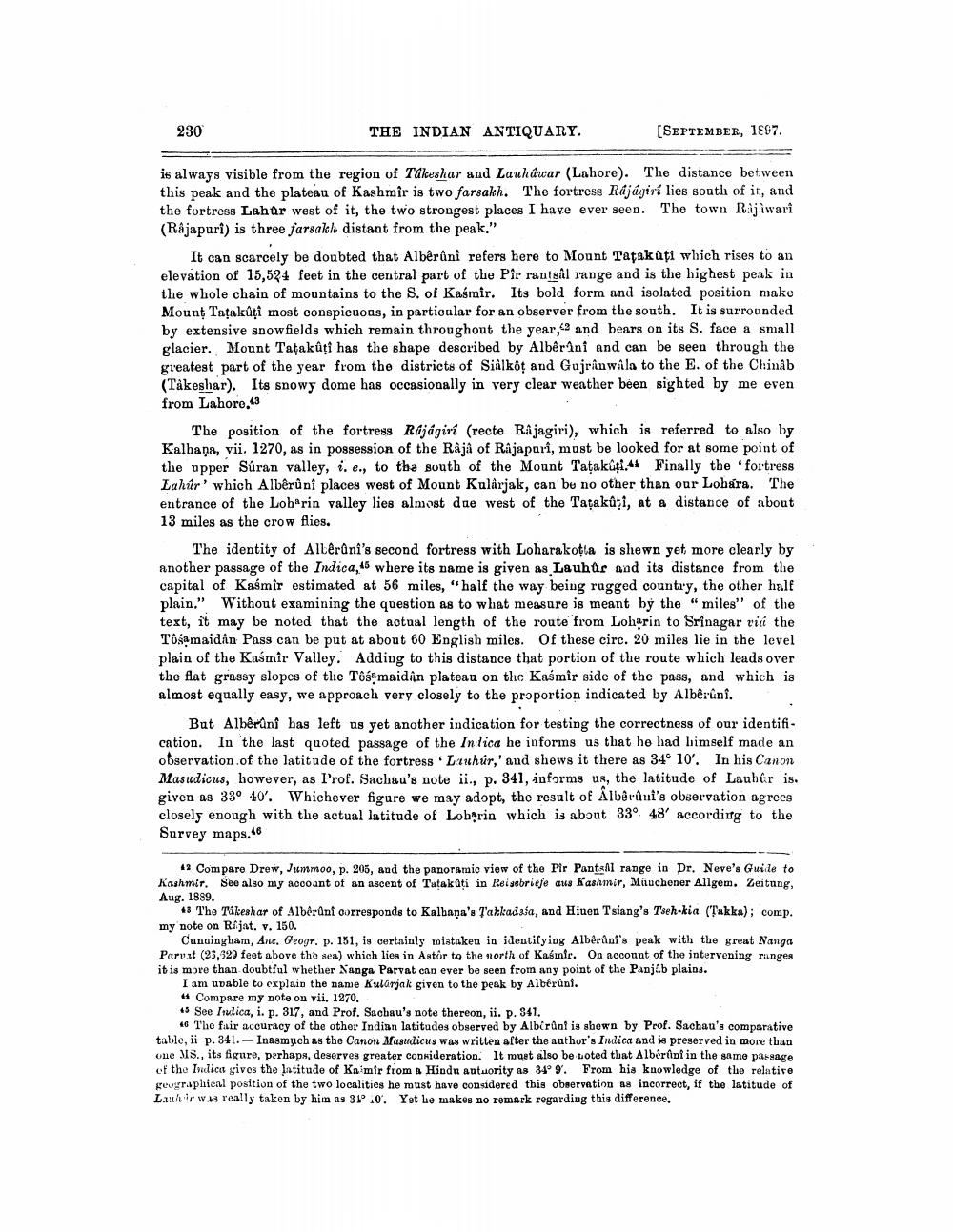________________
230
THE INDIAN ANTIQUARY.
[SEPTEMBER, 1897.
is always visible from the region of Takeshar and Lauhduar (Lahore). The distance between this peak and the plateau of Kashmir is two farsakh. The fortress Rájáyiri lies south of it, and the fortress Lahar west of it, the two strongest places I have ever seen. The town Rajawari (Rajapuri) is three farsakh distant from the peak."
It can scarcely be doubted that Albêrûnî refers here to Mount Tatakati which rises to an elevation of 15,524 feet in the central part of the Pir rantsil range and is the highest peak in the whole chain of mountains to the S. of Kaśmir. Its bold form and isolated position make Mount Tatakuți most conspicuous, in particular for an observer from the south. It is surrounded by extensive snowfields which remain throughout the year, and bears on its S. face a small glacier. Mount Tatakûți has the shape described by Albêrini and can be seen through the greatest part of the year from the districts of Sialkot and Gujranwala to the E. of the Chinab (Tåkeshar). Its snowy dome has occasionally in very clear weather been sighted by me even from Lahore.63
The position of the fortress Rajagiri (recte RÂjagiri), which is referred to also by Kalhaņa, vii. 1270, as in possession of the Raja of Rajapari, must be looked for at some point of the upper Suran valley, i.e., to the south of the Mount Tatakufi. Finally the fortress Lahúr' which Albêrůni places west of Mount Kalårjak, can be no other than our Lohára. The entrance of the Loharin valley lies almost dae west of the Tatakuți, at a distance of about 13 miles as the crow flies.
The identity of Allêruni's second fortress with Loharakotta is shewn yet more clearly by another passage of the Indica,45 where its name is given as Lauhur and its distance from the capital of Kasmir estimated at 56 miles,"half the way being rugged country, the other half plain." Without examining the question as to what measure is meant by the "miles" of the text, it may be noted that the actual length of the route from Loharin to Srinagar vit the Tosamaidan Pass can be put at about 60 English miles. Of these circ. 20 miles lie in the level plain of the Kaśmir Valley. Adding to this distance that portion of the route which leads over the flat grassy slopes of the Tosamaidan plateau on the Kasmir side of the pass, and which is almost equally easy, we approach very closely to the proportion indicated by Albêrûni.
But Albérůni has left as yet another indication for testing the correctness of our identification. In the last quoted passage of the Indica he informs us that he had limself made an observation.of the latitude of the fortress Luhûr,' and shews it there as 34° 10'. In his Canon Masudicus, however, as Prof. Sachan's note ii., p. 341, informs us, the latitude of Lauhûr is. given as 33° 40'. Whichever figure we may adopt, the result of Albêrûui's observation agrees closely enough with the actual latitude of Lob rin which is about 33° 48' according to the Survey maps.
12 Compare Drew, Tummoo, p. 205, and the panoramic view of the Pir Pantall range in Dr. Neve's Guide to Kashmir. See also my accoant of an ascent of Tatakuti in Reisebriefe aus Kashmir, Münchener Allgem. Zeitung, Aug. 1889.
48 The Tikeshar of Albêrunt corresponds to Kalbana's Pakkadafa, and Hiuen Tsiang's Tseh-kia (Takka); comp. my note on Ríjat. v. 150.
Cunningham, Anc. Geogr. p. 151, is certainly mistaken in identifying Albêrûni's peak with the great Nanga Parvat (23,529 feet above the sea) which lies in Astor to the north of Kasmir. On account of the intervening ranges it is more than doubtful whether Nanga Parvat can ever be seen from any point of the Panjab plains.
I am unable to explain the name Kulárjak given to the peak by Albérůni. #Compare my note on vii, 1270. 45 See lulica, i. p. 317, and Prof. Sachau's note thereon, ii. p. 941,
46 The fair accuracy of the other Indian latitudes observed by Alberonl is shown by Prof. Sachau's comparative tablo, ii p. 341.- Inasmuch as the Canon Masudicus was written after the author's Indica and is preserved in more than one S., its figure, perhaps, deserves greater consideration. It must also be noted that Albêrani in the same passage of the Indica gives the latitude of Kaimir from a Hindu antuority as 34° 9. From his knowledge of the relative geographical position of the two localities he must have considered this observation as incorrect, if the latitude of Lau ir wis really taken by him as 31.0. Yet he makes no remark regarding this difference.




